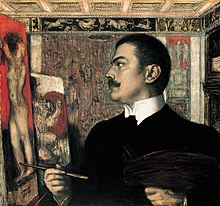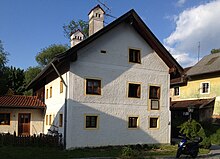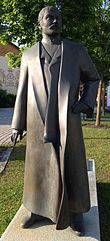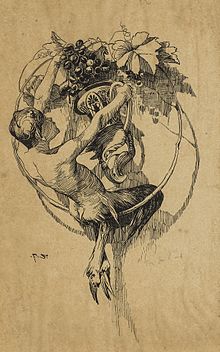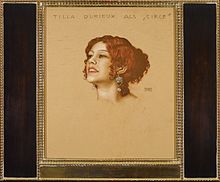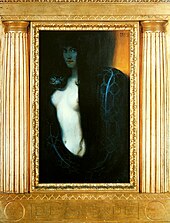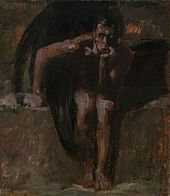Franz von Stuck
Franz Stuck , since 1906 Knight von Stuck (born February 23, 1863 in Tettenweis , Passau district , Lower Bavaria , † August 30, 1928 in Munich ), was a German draftsman , painter and sculptor of Art Nouveau and Symbolism .
Life
As the son of a village miller , Franz Stuck attended the Königliche Kunstgewerbeschule in Munich from 1878 to 1881 , where he was encouraged by Ferdinand Barth to continue his artistic training at the Munich Academy until 1885 . He was first successful as a draftsman. Even during his school days he provided illustrations for magazines.
During his studies he created humorous drawings and designs for the arts and crafts. The twenty-two-year-old artist became known beyond Munich in 1882 with his allegory and emblem designs for the Gerlach & Schenk publishing house in Vienna, a portfolio in which other young artists such as Max Klinger and Gustav Klimt also collaborated. In another collection from the same publisher, cards and vignettes , Stuck successfully continued his witty drafts of classic picture tasks in 1886.
Stuck's name became popular through a series of caricatures for the magazine Fliegende Blätter , for which his teacher at the Ferdinand Barth School of Applied Arts had already worked, whose style the young Stuck was also inspired by. It was not until 1887 that he began to experiment with oil painting.
In 1892, Stuck and Wilhelm Trübner founded the “ Munich Secession ” in opposition to the established artists . Nevertheless, along with Franz von Lenbach and Friedrich August von Kaulbach , he is counted among the Munich painter princes . This is an outward designation, because from an artistic point of view, Stuck was the opposite pole to Lenbach in the dispute that culminated in the establishment of the Munich Secession in the 1890s . During these years he was also a member of the Munich Association for Original Etching , which was close to the Secession.
From 1895 Stuck was a professor at the academy and taught among others Wassily Kandinsky , Paul Klee , Josef Hengge , Georges Kars , Paul Stollreither and Heinrich Strieffler . On behalf of the Cologne chocolate producer Ludwig Stollwerck, he designed collecting pictures for Stollwerck scrapbooks , including the series "The Muses" for the Stollwerck scrapbook no. 4 from 1899.
In 1897 Whistler founded the International Society of Sculptors, Painters and Gravers in London, Stuck was one of the members. In 1903 Franz Stuck was one of the founding members of the German Association of Artists and, as a jury member, also on the extended board of the DKB. At the first Künstlerbund exhibition in 1904, which was still organized by the Munich Secession, Stuck was represented with four large oil paintings.
Prince Regent Luitpold awarded him the Knight's Cross of the Order of Merit of the Bavarian Crown on December 9, 1905 . Associated with this was the elevation to the personal nobility status and he was allowed to call himself "Ritter von Stuck" after his entry in the nobility register on January 2, 1906. In 1912 he received the commander of this order.
In 1906 Stuck was also a founding member of the German Monist Association . In 1914, Stuck signed the Declaration of the Manifesto of 93 , which turned against Allied atrocity propaganda.
At the end of February 1919, Stuck was hostage of the revolutionary Red Guards for a few days during the Munich Soviet Republic . Captured in the Munich suburb of Haidhausen , he met the surgeon Ferdinand Sauerbruch , who had provided medical care to the Eisner assassin Anton von Arco in Munich (later Stuck was part of the domestic affairs of the Sauerbruch couple).
Suggested by Arnold Böcklin , Stuck preferred floating, unreal depictions from the realm of fables and allegorical , symbolic designs such as Sin (1893) and The War (1894; both Bayerische Staatsgemäldesammlungen , Munich). Many of his often large-format works are characterized by a lascivious and erotic atmosphere. Stuck's representations of often naked female or male bodies, e.g. B. The Struggle for Women (1905; Hermitage , St. Petersburg) met with an unusually strong reception in view of the staid moral ideas of the time .
An example of Stuck's idea of a total work of art is his villa, completed in 1898 and built by the Heilmann & Littmann construction company , on Prinzregentenstrasse in Bogenhausen, with furniture and sculptures that he made himself. For this achievement, shortly before his death in 1928, he was awarded an honorary doctorate from the Technical University of Munich . Today the Villa Stuck is a museum ; it reopened in March 2005 after thirteen years of planning, building and restoration work .
For a long time Stuck was seen as a representative of Munich Art Nouveau . This also led to the fact that his villa was later run as an Art Nouveau museum with the seat of the "Art Nouveau Association Franz von Stuck". The art historian and interim director of the museum, Alexander Rauch , first recognized and emphasized the great importance of Stuck as an artist of symbolism through the exhibition Franz von Stuck, which was shown in Passau, Munich, Vienna, Aschaffenburg etc. in 1992 . This resulted in a completely higher reassessment of his work. Above all, the later works of the 1920s - at first far less attention - were recognized as important creations of German, especially Munich, symbolism. The catalog text also analyzes the entire facility and its sequence of images as a refined scenario of symbolist ideas in which biographical and personal elements are interwoven with esoteric and ancient ideas.
Von Stuck was buried in the forest cemetery in Munich / Alter Teil in grave no. 95-W-16. He was the stepfather of Otto Lindpaintner . His only biological child, Franziska Anna Marie-Louise, called Mary (1896–1961), came from a love affair with Anna Maria Brandmaier (1875–1944). Mary was used in 1904 with the approval of the Prince Regent by her father Franz von Stuck and his wife Mary. Lindpaintner (1865–1929, married March 15, 1897). The daughter Mary married the then 31-year-old consul and building contractor Albert Heilmann in 1917 .
For oil painting by stucco today to more than 500,000 dollars paid.
Works (selection)


- Teasing
- The war
- The Sphinx
- The sin
- Riding Amazon (bronze sculpture)
- Salome
- Fight for women , 1903
- Spring dance , 1909, 115 × 100 cm, oil and tempera on wood, Hessisches Landesmuseum Darmstadt
- Poster for the International Hygiene Exhibition Dresden 1911
- spring
- dissonance
- The Guardian of Paradise
- Cupid Imperator .
- Adam and Eva , 1920–1928, Städelsches Kunstinstitut , Frankfurt am Main.
- Lucifer
- Ludwig van Beethoven, high relief (sculpture), Musée d'Orsay, Paris
Works in public collections
Argentina
- Museo Nacional de Bellas Artes, Buenos Aires
Belgium
- Musée d'Ixelles - Museum van Elsene, Brussels
Germany
- Old National Gallery , Berlin
- Hessisches Landesmuseum , Darmstadt
- Städelsches Kunstinstitut , Frankfurt
- Upper Hessian Museum , Giessen
- Lower Saxony State Museum , Hanover
- New gallery , Kassel
- Wallraf Richartz Museum , Cologne
- Landesmuseum Mainz , Mainz
- New Pinakothek , Munich
- State Graphic Collection Munich
- Villa Stuck , Munich
- Municipal gallery in the Lenbachhaus , Munich
- Painting and sculpture collection of the city of Nuremberg , Nuremberg
- Georg Schäfer Museum , Schweinfurt
- State Museum Schwerin , Schwerin
- Museum Baden , Solingen
France
Italy
- Revoltella Museum , Trieste
- Galleria d'Arte Moderna , Palermo
Netherlands
- Van Gogh Museum , Amsterdam
Austria
- Belvedere , Vienna
Russia
- Hermitage , St. Petersburg
Switzerland
- Art Museum St. Gallen , St. Gallen
- Langmatt Museum , Baden AG
Hungary
- Szépművészeti Múzeum , Budapest
United States
- Fogg Art Museum , Cambridge, Massachusetts
student
Honors
- 1889: Gold medal in the glass palace for the painting "The Guardian of Paradise"
- 1897: Gold medal at the Dresden art exhibition
- 1900: Gold medal at the Paris World Exhibition
- 1924: Privy Councilor
- 1926: Member of the Royal Academy of Fine Arts in Stockholm (1926)
- 1928: Dr. Ing. Eh from the Technical University of Munich
literature
- General
- Heinrich Voss: Franz von Stuck (1863-1928). Catalog of works of the paintings with an introduction to its symbolism. Prestel, Munich 1973, ISBN 3-7913-0337-6 .
- Franz von Stuck and his students: paintings and drawings. Stuck Art Nouveau Association, Munich 1989, ISBN 3-923244-09-6 .
- Alexander Rauch: Symbolism between “Paradise” and “Sin” - The artist's work and his villa , in: The Stuck Villa in Munich, staging of an artist's life, published by Bayerische Vereinsbank Munich, Munich 1992, pp. 24–72.
- Alexander Rauch: On the work of the symbolist Franz von Stuck (1863–1928) in: Franz von Stuck, exhibition catalog, Museum Moderner Kunst Passau (Gerwald Sonnberger) with a contribution by Eva Heilmann (The sculptural work), Passau 1993 (further stations Vienna, Munich , Aschaffenburg, Amsterdam etc.).
- Eva Mendgen: Franz von Stuck 1863–1928. "A prince in the realm of art" . Taschen, Cologne 1994, ISBN 3-8228-8953-9 .
- Jo-Anne Birnie Danzker u. a. (Ed.): Franz von Stuck and photography. Staging and documentation . Prestel, Munich 1996, ISBN 3-7913-1657-5 (exhibition catalog).
- Jo-Anne Birnie Danzker (Ed.): Franz von Stuck. The collection of the Museum Villa Stuck . Arranged by Barbara Hardtwig. Edition Minerva, Eurasburg, 1997, ISBN 978-3-932353-09-3 (exhibition catalog).
- Vera Losse: Stuck, Franz von. In: Biographisch-Bibliographisches Kirchenlexikon (BBKL). Volume 11, Bautz, Herzberg 1996, ISBN 3-88309-064-6 , Sp. 114-118.
- Claudia Gross-Roath: Franz von Stuck's image of women. VDG, Weimar 1999, ISBN 3-89739-070-1 .
- Birgit Jooss : Ateliers as consecration places for art. The "artist altar" around 1900 . Association for the Promotion of Villa Stuck, Munich 2002, ISBN 3-923635-45-1 .
- Birgit Jooss: “Farmer's son who thrived to be the prince of art”: the staging strategies of the artist princes in historicism . In: Plurale. Magazine for thought versions. Book 5 - Profit. Edited by Mirjam Goller, Guido Heldt, Brigitte Obermayer and Jörg Silbermann. Berlin 2005, pp. 196–228.
- Jo-Anne Birnie Danzker (Ed.): The Villa Stuck. Hatje Cantz Verlag, Ostfildern 2006, ISBN 978-3-7757-1897-4 .
- Franz von Stuck - Lucifero moderno . Exhibition catalog Mart Trento. Skira, Milan 2006.
- Agnes Husslein-Arco and Alexander Klee (eds.): Sünde and Secession. Franz von Stuck in Vienna, Hirmer Verlag, Munich 2016, ISBN 978-3-7774-2693-8 .
- Eva Chrambach: Stuck, Franz Xaver von. In: New German Biography (NDB). Volume 25, Duncker & Humblot, Berlin 2013, ISBN 978-3-428-11206-7 , pp. 612-614 ( digitized version ).
- To individual works
- Thomas Blisniewski : "The naked woman beckons with glowing eyes" - "The sin" Franz von Stucks in the Wallraf-Richartz Museum . Corboud Foundation. In: Cologne Museum Bulletin. Reports and research from the museums of the city of Cologne (1) . 2004, pp. 22-33.
Web links
- Works by Franz von Stuck at Zeno.org .
- Literature by and about Franz von Stuck in the catalog of the German National Library
- Pictures by Franz von Stuck
- Museum Villa Stuck in Munich
- Museum where Franz von Stuck was born in Tettenweis
- Franz von Stuck in HeidICON illustrations of the flying leaves
- Franz von Stuck and his students. Discussion of the exhibition in Langenargen (April 13 to October 12, 2014), on the SWR2 website
Individual evidence
- ^ Franz von Stuck , in: Nathalia Brodskaïa: Symbolismus , Sirrocco / Art of Century Collection, London 2007. ISBN 978-1-84484-416-6 (p. 180 f.).
- ^ Andreas Strobl: Il disegno come quadro. Stucco disegnatore. In: Franz von Stuck - Lucifero moderno . Exhibition catalog Mart Trento. Skira, Milan 2006, pp. 43-47.
- ↑ Detlef Lorenz: Advertising art around 1900. Artist lexicon for collecting pictures. Reimer-Verlag, Berlin 2000.
- ↑ kuenstlerbund.de: Ordinary members of the German Association of Artists since it was founded in 1903 / Stuck, Franz von ( Memento of the original from March 4, 2016 in the Internet Archive ) Info: The archive link was inserted automatically and has not yet been checked. Please check the original and archive link according to the instructions and then remove this notice. (accessed April 14, 2016).
- ^ Exhibition catalog X. Exhibition of the Munich Secession: The German Association of Artists (in connection with an exhibition of exquisite products of the arts in the craft) , Verlaganstalt F. Bruckmann, Munich 1904 (p. 31: Stuck, Franz, Munich. Catalog numbers 151–154: Susanne , the well-wisher , Olga , Spanish dancer ).
- ↑ Heiko Weber: Monistic and Antimonistic Weltanschauung. A selection bibliography. Ernst Haeckel House Studies Vol. 1. Berlin 2000, ISBN 3-86135-480-2 . P. 21.
- ^ Foundation German Historical Museum: Just seen on LeMO: LeMO biography. Retrieved July 12, 2019 .
- ^ Ferdinand Sauerbruch, Hans Rudolf Berndorff : That was my life. Kindler & Schiermeyer, Bad Wörishofen 1951; cited: Licensed edition for Bertelsmann Lesering, Gütersloh 1956, pp. 247–250 and 288.
- ↑ Alexander Rauch: Symbolism between “Paradise” and “Sin” - The artist's work and his villa , in: The Stuck Villa in Munich, Staging of an Artist's Life , Munich 1992.
- ^ Page of Christie's auction house , accessed on August 21, 2012.
- ^ Equipo de Desarrollo de la Dirección de Sistemas | Secretaría de Gobierno de Cultura: Batsheba (Betsabé). Retrieved June 8, 2020 .
- ↑ From Reform Dress to Champagne Bowl »Mathildenhöhe Darmstadt. Museum, artist colony. Retrieved January 23, 2017 .
| personal data | |
|---|---|
| SURNAME | Stuck, Franz von |
| ALTERNATIVE NAMES | Stuck, Franz; Stuck, Franz Xaver; Stuck, Franz Ritter von |
| BRIEF DESCRIPTION | German painter and sculptor |
| DATE OF BIRTH | February 23, 1863 |
| PLACE OF BIRTH | Tettenweis , Passau district |
| DATE OF DEATH | August 30, 1928 |
| Place of death | Munich |
